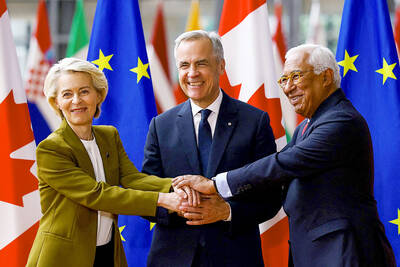Stargazers across a swathe of the world marveled at a dramatic red “Blood Moon” during a rare total lunar eclipse in the early hours of yesterday morning.
The celestial spectacle was visible in the Americas and Pacific and Atlantic oceans, as well as in the westernmost parts of Europe and Africa.
The phenomenon happens when the sun, Earth and moon line up, causing our planet to cast a giant shadow across its satellite. But as the Earth’s shadow crept across the moon, it did not entirely blot out its white glow — instead the moon glowed a reddish color.

Photo: Reuters
This is because the only sunlight that reaches the moon is “bent and scattered,” as it goes through Earth’s atmosphere, said Daniel Brown, an astronomer at Britain’s Nottingham Trent University.
It is similar to how the light can become pink or red during sunrises or sunsets on Earth, he added.
The more clouds and dust there are in Earth’s atmosphere, the redder the moon appears.
Brown called the lunar eclipse, which lasted about six hours, “an amazing way to see the solar system in action.”
The period when the moon is completely in Earth’s shadow — called the totality — lasts just more than an hour.
This event has been dubbed the “Blood Worm Moon,” after one of the names given to March full moons by some Native Americans.
In North America, the moon started to look like a bite was being taken out of it from 1:09am Eastern Time, with the totality from 2:26am to 3:31am. NASA said.
In France, the totality was from 7:26am to 8:31am, the French Institute of Celestial Mechanics and Ephemeris Calculation said.
Only the most western parts of Europe, such as France’s Brittany region, got a chance to see the totality before the moon set.
People in New Zealand have the opposite problem, with the eclipse only partially visible as the moon rose.
Brown dislikes the term “blood moon,” saying it has a negative connotation and “originates from a misinformed theory of the end of the world.”
But not all societies took a negative view of these celestial shows.
Some people in Africa traditionally viewed a lunar eclipse as a conflict between the sun and moon that could be resolved by people “demonstrating on Earth how we work together” and laying old feuds aside, Brown said.
He called it “an amazing story that should inspire us all.”

‘SHORTSIGHTED’: Using aid as leverage is punitive, would not be regarded well among Pacific Island nations and would further open the door for China, an academic said New Zealand has suspended millions of dollars in budget funding to the Cook Islands, it said yesterday, as the relationship between the two constitutionally linked countries continues to deteriorate amid the island group’s deepening ties with China. A spokesperson for New Zealand Minister of Foreign Affairs Winston Peters said in a statement that New Zealand early this month decided to suspend payment of NZ$18.2 million (US$11 million) in core sector support funding for this year and next year as it “relies on a high trust bilateral relationship.” New Zealand and Australia have become increasingly cautious about China’s growing presence in the Pacific

The team behind the long-awaited Vera Rubin Observatory in Chile yesterday published their first images, revealing breathtaking views of star-forming regions as well as distant galaxies. More than two decades in the making, the giant US-funded telescope sits perched at the summit of Cerro Pachon in central Chile, where dark skies and dry air provide ideal conditions for observing the cosmos. One of the debut images is a composite of 678 exposures taken over just seven hours, capturing the Trifid Nebula and the Lagoon Nebula — both several thousand light-years from Earth — glowing in vivid pinks against orange-red backdrops. The new image

ESPIONAGE: The British government’s decision on the proposed embassy hinges on the security of underground data cables, a former diplomat has said A US intervention over China’s proposed new embassy in London has thrown a potential resolution “up in the air,” campaigners have said, amid concerns over the site’s proximity to a sensitive hub of critical communication cables. The furor over a new “super-embassy” on the edge of London’s financial district was reignited last week when the White House said it was “deeply concerned” over potential Chinese access to “the sensitive communications of one of our closest allies.” The Dutch parliament has also raised concerns about Beijing’s ideal location of Royal Mint Court, on the edge of the City of London, which has so

Canada and the EU on Monday signed a defense and security pact as the transatlantic partners seek to better confront Russia, with worries over Washington’s reliability under US President Donald Trump. The deal was announced after a summit in Brussels between Canadian Prime Minister Mark Carney and European Commission President Ursula von der Leyen and European Council President Antonio Costa. “While NATO remains the cornerstone of our collective defense, this partnership will allow us to strengthen our preparedness ... to invest more and to invest smarter,” Costa told a news conference. “It opens new opportunities for companies on both sides of the